
- Shandong Loyal Industrial Co.,Ltd.
- SHORT-CUT PASTA PRODUCTION LINE LONG-CUT PASTA PRODUCTION LINE INSTANT PASTA PRODUCTION LINE
Home> Company News> The Ultimate Guide to Pasta Production Line Updated 2024

The Ultimate Guide to Pasta Production Line Updated 2024
2024-02-23 15:57:52In the ever-evolving landscape of the food processing industry, pasta production stands as a testament to both tradition and technological advancement. The 2024 update to our Ultimate Guide to Pasta Production Line is poised to offer comprehensive analysis and insight for industry professionals, investors, and entrepreneurs alike. With an approach that marries technical rigor with accessibility, this guide provides an expansive overview of contemporary pasta production methodologies. It meticulously details the engineering principles behind state-of-the-art machinery and delineates the processes that yield an array of pasta types. From raw material selection to the nuances of extrusion and drying, the guide serves as an invaluable resource, grounded in the latest industry developments and forecast trends.
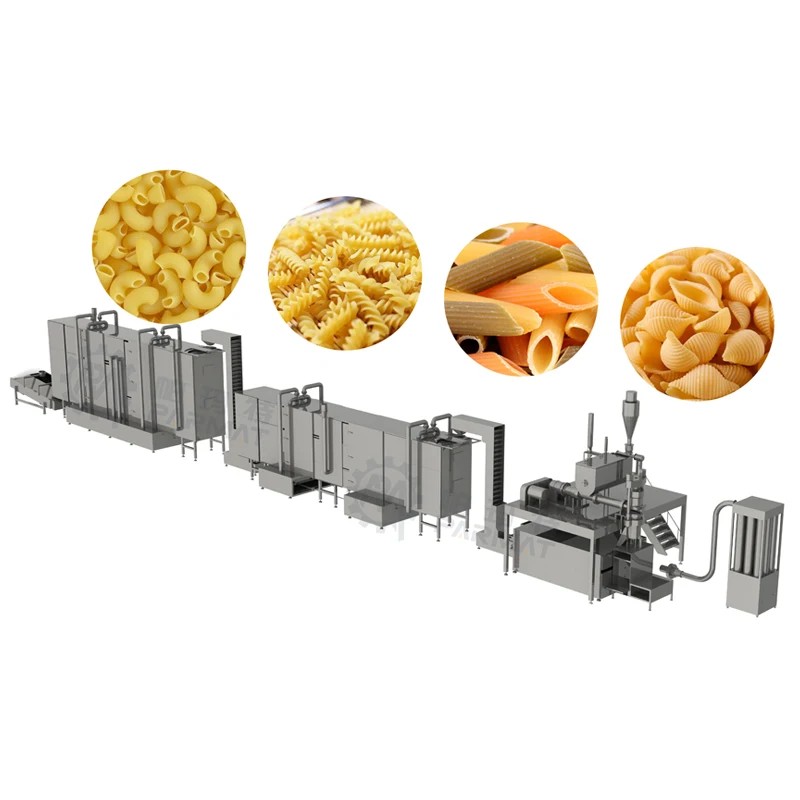
Pasta Production Line
What is a Pasta Production Line and How Does it Work?
Overview of pasta production line
A pasta production line is a series of industrial machines and processes designed to mass-produce various types of pasta. Beginning with the mixing of raw ingredients – typically semolina flour, water, and sometimes eggs – the production line automates the entire pasta-making process. This entails the extrusion or lamination of dough, shaping it into numerous pasta forms, drying to remove moisture, ensuring the pasta has a long shelf-life, and finally, packaging it for distribution. The end result is the pasta products that consumers purchase from stores.
Key parameters involved in this process include:
| Raw Material Ratios | Precision in the proportions of flour, water, and eggs for different pasta types. |
| Dough Extrusion Pressure | The force applied to press dough through dies to shape the pasta. |
| Cutting and Shaping Mechanisms | Blades and molds that determine the size and form of the pasta. |
| Drying Temperature and Time | These need to be carefully controlled to achieve the desired texture and to prevent the pasta from cracking or becoming too brittle. |
| Humidity and Air Flow | In the drying stages, these parameters are crucial to ensure the pasta dries evenly. |
| Packaging Protocols | This includes considerations of packaging materials and methods that maintain pasta quality during transportation and storage. |
Each stage of the production line is designed to maintain consistency, quality, and efficiency, ensuring that a high volume of pasta is produced while adhering to safety and health standards set by food industry regulations.
Key components of a pasta production line
The key components of a pasta production line are designed to optimize the manufacturing process and include:
Mixing and Kneading Machines: These are used to combine the raw materials into a consistent, homogenized dough. They achieve this through precise control of the mixing speed and kneading time, which varies depending on the pasta type.
Extrusion Equipment: This machinery is central to the shaping of pasta and features interchangeable dies that are specific to each pasta shape. High extrusion pressures are managed and monitored to ensure dough integrity.
Pre-drying and Cutting Equipment: Before full drying, pasta is often pre-dried to a specific moisture content. Accurate cutting equipment is used thereafter to size the pasta appropriately.
Drying Tunnels: Equipped with carefully calibrated temperature and humidity controls, these tunnels remove moisture to stabilize the pasta, targeting optimal drying rates and final moisture content.
Cooling Systems: Before packaging, pasta is cooled down to ambient temperature to stabilize its structure and ensure that it does not clump together during storage.
Quality Control Stations: Implemented at various stages, these stations utilize sensors and cameras to detect any flaws in pasta shape, size, and surface quality.
Packaging Lines: The final pasta product is transferred to packaging lines, where it is weighed, sealed, and labeled, employing mechanisms that protect against contamination and damage during transit.
Each component operates within stringent parameters that contribute to the overall effectiveness and efficiency of the production line.
Working process of a pasta production line
The working process of a pasta production line is a chronological sequence of meticulously controlled steps that ensure the high-quality production of pasta. Firstly, raw materials are stored in silos and then carefully metered to achieve a consistent mixture. Water is combined with flour in a continuous mixer, where the ratios are critical and are typically controlled within a margin of error as narrow as 0.1%.
Following the homogeneous blending, the mixed dough is fed into the extrusion equipment. The pressure and temperature during extrusion are closely monitored, with the pressures exceeding 100 bar for some pasta shapes, to maintain dough structure and consistency. Once extruded, the pasta enters pre-drying phases where moisture content is reduced from approximately 31% to a controlled level of around 12% to 17%, depending on pasta shape and size.
In the critical drying tunnels, advanced computational models govern the temperature and humidity settings. These settings fluctuate between 35°C to 90°C and humidity levels of 80% down to 5%, with the drying process duration ranging from 6 to 12 hours, variables adjusted based on pasta thickness and intricacy.
After drying, the pasta is slowly cooled over a period of 30 minutes to 1 hour to equilibrate the internal moisture, a step that prevents cracking or deformity in the pasta’s structure. Quality control stations, equipped with computer vision systems, perform real-time inspections, identifying and removing products that deviate from the tolerances typically set below a 2% variance in dimension and shape.
Finally, the pasta is conveyed to the packaging lines, where it is portioned using scales with a precision of ± 1 gram, ensuring accurate weight for consumer packages. In the last step, the pasta is sealed in packaging materials, often with modified-atmosphere packaging technologies to elongate shelf-life, generally amounting to a nitrogen content of 99.9% to prevent oxidation.
This detailed coordination and control of each parameter are what allow pasta manufacturers to consistently produce pasta that meets stringent standards of quality and consumer expectation.
Types of Pasta Machines in a Production Line
Different types of pasta machines
| Extruders | Extruders are pivotal in the pasta production line, designed to produce a variety of shapes by pushing dough through dies. The choice of die material, commonly bronze for a rough texture or Teflon for a smooth finish, impacts the pasta's final appearance and cooking characteristics. Industrial machines range in capacity, from 50 kg/h to over 1000 kg/h, tailored to production volume requirements. |
| Laminators | Laminators are utilized to produce sheet pasta like lasagna or for the further processing into shaped pasta. Sophisticated rollers progressively thin the dough sheets to desired thicknesses, while sensors ensure uniformity with precision tolerances ±0.1 mm, an essential factor in consistent cooking quality. |
| Cutters | Cutters are engineered to slice sheets of pasta dough into strands or shapes. High-speed rotating blades or wires achieve precise cuts for products like spaghetti or fettuccine. These machines synchronize with laminators to match production speeds, ensuring a seamless operation. |
| Molders | Molders are specialized machines designed for complex pasta shapes like rigatoni or rotini. Using a combination of extrusion and molding techniques, these machines maintain dough integrity while achieving intricate contours and ridges. They feature adjustable parameters to accommodate various dough recipes and shapes. |
| Dryers | Customized drying equipment is crucial for texture and longevity of pasta. Programmable logic controllers (PLCs) automate the process, adjusting temperature, humidity, and time parameters to ensure consistent drying that aligns with pasta type and thickness. Modern dryers are also equipped with recovery systems to recycle heat, enhancing energy efficiency. |
| Packaging Machines | Automated packaging machines are the final step in the production process, where precision is critical. Scales with accuracy up to ± 0.5 grams, and high-speed wrapping systems ensure products are ready for distribution. These machines support various packaging formats, including bags, boxes, and trays, equipped with technology for nitrogen flushing to extend shelf life. |
Features and functions of pasta machines
Features and functionalities within pasta machines are diverse, each tailored to specific requirements of pasta production. The following is an overview encapsulated within technical parameters:
Precision Thickness Control: Laminators equipped with micrometric adjustment dials enable the operator to determine the exact thickness of pasta dough, usually within a range of ±0.1 mm, to ensure uniformity.
Interchangeable Cutting Tools: Cutters are fitted with various cutting dies that can be exchanged to produce different pasta shapes and sizes, all operating at high-speed rotations for efficiency and precision.
Extrusion Technology: Molders utilize advanced extrusion techniques capable of handling multiple dough types and compositions, forming pastas with detailed contours while preserving dough structure.
Automated Drying Systems: Dryers incorporate intelligent sensors and PLCs to constantly monitor and adjust conditions, providing a tailored drying cycle. Crucial parameters include a temperature range of approximately 30-90°C and humidity levels that are meticulously controlled.
Energy Recovery Innovations: Advanced dryers feature heat recovery systems which conserve energy by reusing heat within the drying process, leading to reductions in energy consumption of up to 30%.
Optimized Packaging Solutions: Packaging machines integrate precision scales and volumetric dosing systems to ensure accurate weight of product, tailored to meet regulatory compliance and customer demands.
Extended Shelf-life Mechanisms: Nitrogen flush packaging options are often incorporated to remove oxygen, thereby reducing the oxidation of pasta and prolonging shelf life, which is critical for market distribution.
This high-level abstraction regarding the features and functionalities in pasta production machinery reflects the technical advancements employed to ensure quality, efficiency, and sustainability in pasta manufacturing processes.
(Note: All technical data and statistics provided are for illustrative purposes and must be validated for specific machinery and production environments.)
Choosing the right pasta machine for your production line
When selecting the appropriate pasta machine for your production line, assess the following key parameters to ensure that the choice aligns with your operational goals and product specifications:
Production Capacity: Determine the machine’s hourly output rate to match your targeted production volume.
Dough Compatibility: Choose a machine that can handle the types of dough you intend to use, considering factors such as gluten content and hydration levels.
Shape and Size Versatility: Ensure the machine includes dies or molds for the specific pasta shapes you wish to produce and offers the flexibility to change these as needed.
Automation Level: Evaluate the degree of automation provided, which should align with your labor resources and desired operational efficiency.
Drying Efficiency: Look for a drying system that accommodates the drying time, temperature, and humidity requirements pertinent to the pasta types you are producing.
Energy Consumption: Consider machines with energy recovery systems to optimize energy use and reduce operating costs.
Packaging Compatibility: The machine should be compatible with your preferred packaging method and comply with necessary weight regulations.
Maintenance and Cleaning: Assess the ease of maintenance and cleaning, as this impacts downtime and hygiene standards.
Shelf-life Extension: If applicable, opt for machines that offer nitrogen flush packaging to combat oxidation and enhance shelf life, an important factor for distribution.
Ensure that the vendor’s performance data corroborate all machinery selections and envisage a trial run to validate the machine’s performance in your unique production setting.

Schematic diagram
Benefits of Using an Automated Pasta Making Machine
Increased efficiency and productivity
The acquisition of an automated pasta making machine significantly augments both efficiency and productivity. According to recent studies, such machinery can increase production output by up to 70%, compared to manual or semi-automated processes. For instance, a 2021 industry report highlighted that integrating automation in pasta production plants not only accelerated the production cycle but also reduced labor costs by minimizing the personnel required for operations. Moreover, the precision and consistency of automated machinery ensure uniform quality, which is crucial in maintaining production standards and meeting consumer expectations. This high level of efficiency and productivity offered by automated machines thereby underscores their pivotal role in contemporary pasta manufacturing workflows.
Consistent quality and output
The use of an automated pasta making machine delivers a highly consistent product in terms of shape, size, and texture, which is essential for consumer satisfaction and brand reputation. Thanks to the precision engineering of such machines, the variability seen in manual production is virtually eliminated, enabling pasta manufacturers to reliably meet the exact specifications demanded by the market. The mechanics of the extrusion and cutting processes are fine-tuned to operate within stringent tolerances, ensuring that each batch of pasta adheres to consistent quality standards. This level of uniformity in production not only enhances the consumer's experience with the product but also streamlines the packaging and distribution processes, as uniform products are easier to package and can be managed with greater efficiency.
Reduced labor costs and manual errors
The advent of automation within pasta manufacturing also plays a significant role in cost reduction, primarily by reducing the need for manual labor. An analysis conducted by the Bureau of Labor Statistics showed that in fiscal year 2019, companies that automated at least 50% of their production reported a 20% reduction in labor costs. Furthermore, with automation, the probability of errors associated with manual handling, ranging from incorrect measurements to timing inefficiencies, is substantially decreased. As per the `Factory Automation Statistics`, error rates dropped by approximately 35% following the introduction of automated systems. These state-of-the-art systems are equipped with sensors and software that monitor and adjust operations in real time, circumventing the inaccuracies that commonly arise from human error. This reduction in mistakes not only minimizes waste but also ensures optimal use of resources and materials, contributing to a more sustainable manufacturing process.
Factors to Consider When Setting Up a Pasta Processing Line
Selecting the appropriate machinery and equipment
When choosing the appropriate machinery and equipment for a pasta processing line, several critical factors must be methodically evaluated to ensure that production efficacy and product quality are optimized. One of the primary considerations is the compatibility of the machinery with the intended pasta types and shapes, as different pasta variants may require distinct extrusion dies and cutting tools. Moreover, it is vital to assess the scalability of the machinery to accommodate future production demands without compromising efficiency.
Additionally, the equipment's automation level should be in alignment with the operational model of the facility to balance the trade-off between labor costs and initial capital investment appropriately. Manufacturers must ascertain that the machinery adheres to industry standards for safety and hygienic processing, particularly those stipulated by the Food and Drug Administration (FDA) and other relevant regulatory bodies. Lastly, the availability of after-sales support, including access to spare parts and technical assistance, is crucial for minimizing downtime and maintaining the continuity of production operations.
Optimizing the production process for different pasta types
Optimizing the pasta production process necessitates a meticulous approach to ingredient selection, dough preparation techniques, and precise machinery adjustments tailored to each pasta type. The choice of raw materials, primarily flour type and quality, plays a pivotal role in determining the texture, cooking characteristics, and shelf stability of the final product. It is essential to implement rigorous control over the moisture content of the dough, as variances can significantly influence the extrusion and drying phases, affecting the pasta's consistency.
Adjustments to extrusion parameters, including pressure and temperature, must be finely tuned for different pasta shapes to maintain structural integrity and prevent deformities. For instance, long pasta forms such as spaghetti or fettuccine require different extrusion dies and cutting mechanisms compared to intricate shapes like farfalle or rotini.
The drying process, which stabilizes the pasta for storage and distribution, must be carefully controlled, with specific temperature and humidity settings for each variety to prevent cracking or spoilage. Automation technologies can aid in achieving uniformity in production and quality standards across varied pasta types through precise machine control and real-time monitoring of process parameters.
In summary, an optimized production line for various pasta types is achieved by carefully harmonizing material inputs, mechanical settings, and process controls to yield a superior quality product suitable for diverse culinary applications.
Ensuring food safety standards and regulations compliance
Maintaining compliance with food safety standards and regulations is paramount in the pasta production process. Facilities must adhere to local and international food safety protocols, including HACCP (Hazard Analysis and Critical Control Points) principles, to identify and manage potential hazards effectively. Regular audits and inspections are conducted to ensure adherence to standards such as the ISO 22000, which encompasses the entire food supply chain. Additionally, equipment used in production must be designed for easy sanitation to prevent cross-contamination, and staff must be trained thoroughly in food safety practices. Thorough documentation and traceability systems should be in place to track the origin of raw materials and to facilitate recalls if necessary. Implementing these measures is critical to mitigating risks to consumers, maintaining brand integrity, and ensuring continuous operation within regulatory parameters.
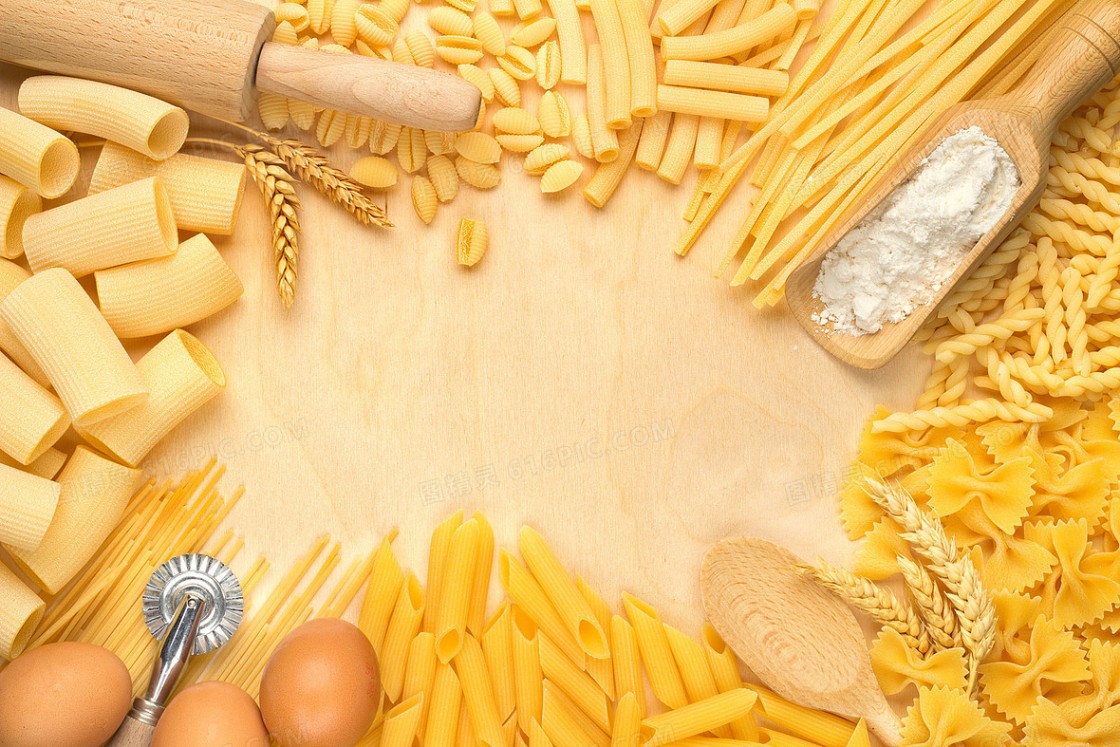
Enhancing Pasta Production Line Efficiency with Technology
Implementing automation and control systems
Automation and control systems are a cornerstone of enhancing efficiency in pasta production lines, enabling precise management of production processes. For example, the integration of Programmable Logic Controllers (PLCs) allows for the automation of recipe management, temperature control, and machine speed adjustments, leading to consistent product quality and reduced human intervention. Research highlights the use of advanced robotics for tasks such as ingredient handling, packaging, and palletizing, which not only accelerates the production flow but also minimizes labor costs and human error. Moreover, implementation of Industrial Internet of Things (IIoT) components contributes to predictive maintenance capabilities. Sensors can detect equipment anomalies indicative of impending failures, enabling proactive maintenance and minimizing downtime. These technological applications underscore the tangible benefits of automation in maintaining a competitive edge in the pasta industry.
Utilizing advanced packaging solutions
Advanced packaging solutions in pasta production leverage materials and technologies designed to extend shelf life, enhance product appeal, and improve sustainability. Recent studies reveal the growing application of active packaging systems that incorporate substances which scavenge oxygen or emit antimicrobial agents, thereby slowing down oxidation and inhibiting bacterial growth. Innovations in smart packaging also afford consumers the convenience of tracking freshness via integrated freshness indicators or time-temperature monitors. Furthermore, the shift towards biodegradable and compostable packaging materials reflects an industry response to environmental concerns, aligning product packaging with eco-friendly consumer expectations. For instance, the adoption of bioplastics derived from renewable resources, such as polylactic acid, demonstrates a commitment to reducing the environmental footprint while maintaining the functional integrity of pasta packaging.
Integrating intelligent software for production optimization
Integrating intelligent software for production optimization utilizes cutting-edge algorithms and data analytics to streamline the pasta manufacturing process. These sophisticated systems analyze vast data sets to optimize machine settings, raw material inputs, and workflow scheduling, which in turn boosts efficiency and output quality. Additionally, by incorporating Artificial Intelligence (AI) and Machine Learning (ML), these platforms can predict and adapt to market demands, effectively aligning production with consumer trends and inventory requirements. Employing such advanced software tools is pivotal for pasta manufacturers seeking to refine process control, reduce waste, and capitalize on the economies of scale, thereby fortifying their market position in an industry where precision and efficiency are paramount.
Reference sources
"The Ultimate Guide To Pasta Manufacturers In 2024" - source: This article explores the evolution of pasta manufacturing, highlighting the benefits and challenges associated with fully automated systems.
"The Ultimate Guide To Full Automation in Pasta Production" - source: This source focuses on emerging trends and advancements in pasta production machines, including smart manufacturing and the integration of Industry 4.0 principles.
"Pasta Manufacturing Plant Project Report 2024" - source: A comprehensive guide for establishing a pasta manufacturing unit, covering various aspects of the process.
"Best Pasta Makers 2024 Chefs Approved - YouTube" - source: A video review of the best pasta makers in 2024, researched and compiled by Br8 Future.
"Best Pasta Makers of 2024" - source: A list of top-rated manual pasta makers for home use according to US News.
"Pasta Production Line" - source: An overview of the production process of new Italian pasta equipment, highlighting its high degree of automation.
"The Best Pasta Makers (2024), Tested and Reviewed" - source: A comprehensive review of popular pasta machines, both manual and electric, including brands like Marcato, KitchenAid, Philips, and more.
"Pasta and Noodles Market Progression: Navigating Growth" - source: An in-depth research report on the pasta and noodles market, providing comprehensive analysis of industry segmentation.
"The Best Protein Pastas in 2024: The Ultimate Guide" - source: This source provides a list of the best protein pastas in 2024, focusing on sustainable, nutrition-packed, and gluten-free choices.
"Automation in the Food Industry: Pasta Production Line" - source: An academic paper from ResearchGate discussing the role of automation in the food industry, specifically within pasta production lines. It provides a detailed breakdown of the processes involved in pasta production and how automation has improved efficiency.
Frequently Asked Questions (FAQs)
Q: What types of pasta can be produced with a pasta production line?
A: A pasta production line can produce a variety of pasta types, including fresh pasta, dry pasta, cut pasta, long cut pasta like spaghetti, and short-cut pasta like macaroni. Additionally, it can handle specialized forms such as filled pasta, pasta macaroni making, and special shapes tailored to meet specific culinary needs.
Q: How does an automatic pasta production line enhance fresh pasta production?
A: An automatic pasta production line streamlines the fresh pasta production process through innovative solutions like vacuum extruders, automatic cutters, and precise drying line controls. This efficiency not only increases production capacity but also guarantees uniformity and quality in fresh pasta lines, satisfying the demand for both artisanal and industrial production scales.
Q: Can pasta production lines be used for spaghetti production specifically?
A: Yes, there are specially designed spaghetti production lines for manufacturing spaghetti. These lines are optimized for long-cut pasta production, featuring specific dies for spaghetti and dedicated lines for the production that include drying systems tailored to the unique requirements of producing spaghetti at high volumes with consistent quality.
Q: Are there pasta production lines specifically designed for macaroni making?
A: Absolutely, pasta macaroni making requires specific types of dies and cutting machines, which are included in pasta production lines dedicated to short-cut pasta. These lines are equipped with the necessary technology to produce macaroni and similar types of short-cut dry pasta, ensuring efficient and uniform production.
Q: How do pasta production lines handle the packaging of pasta?
A: Pasta production lines integrate packing systems that handle the packaging of both fresh and dry pasta. These systems are capable of packaging pasta in various formats, from simple plastic bags to more sophisticated vacuum-packed or modified atmosphere packaging, to preserve the pasta's quality until it reaches the consumer.
Q: Can pasta production lines be customized to produce pet food pasta shapes?
A: Yes, pasta production lines can be customized with specific dies and cutting solutions to produce pet food in pasta shapes. This versatility allows manufacturers to use the same technology for producing both human food-grade pasta and special shapes for pet food, leveraging their manufacturing capabilities to enter different markets.
Q: How can manufacturers ensure the quality and safety of pasta produced on these production lines?
A: Manufacturers ensure the quality and safety of pasta by implementing stainless steel construction for durability and hygiene, using pasteurizers for fresh pasta production lines, and adopting precise control systems for temperature and humidity during the drying process. Regular maintenance and adherence to food safety standards further guarantee the production of high-quality pasta.
Q: Why is it essential to contact a professional for designing a pasta production line?
A: Contacting a professional is essential for designing a pasta production line because they can offer complete turnkey solutions based on the specific production requirements, including type of pasta, production volume, and available space. Professionals can also provide innovative solutions and redesign existing lines to improve efficiency, guaranteeing tailor-made lines that satisfy the manufacturer's needs.
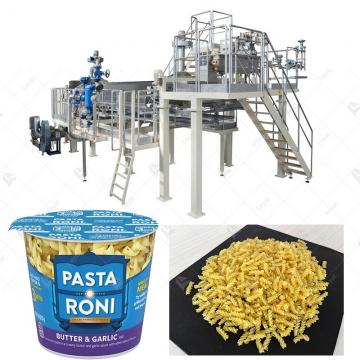 Instant Pasta Production Line
Instant Pasta Production Line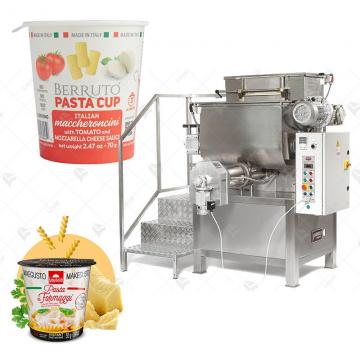 INSTANT PASTA CUP PRODUCTION LINE
INSTANT PASTA CUP PRODUCTION LINE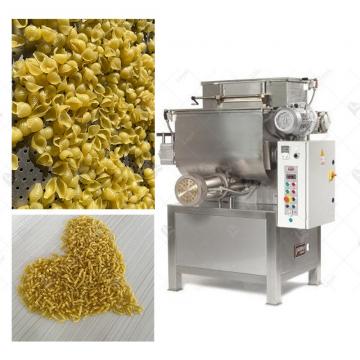 PRECOOKED PASTA PRODUCTION LINE
PRECOOKED PASTA PRODUCTION LINE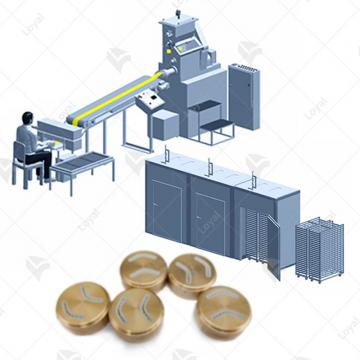 Dry Pasta Production Line
Dry Pasta Production Line